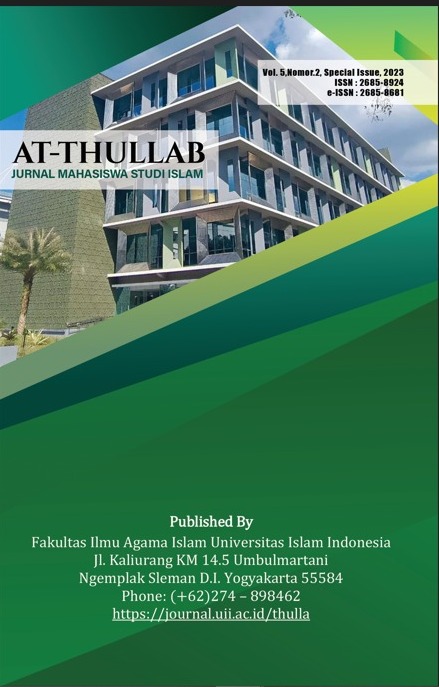Main Article Content
Abstract
As a result of the industrial revolution, technological developments in the world are increasingly massive. Almost all systems of human life are assisted by sophisticated technologies and are connected to the internet. This aims to facilitate human work and activities, including government services which currently have many collaborated with sophisticated technology in maximizing public services. This step is seen as the right step, considering the sophistication of existing technology that is considered more effective and efficient in carrying out public services. As for Islam, the technological progress that enters almost all aspects of human life is seen as a form of maslahah mursalah, which is something that is permissible by syara' as long as it is good acording to the reason and can provide good also avoid bad things for humans. One of the government institutions that uses technology in providing services to the public is the religious court, as a legal instrument where the community can seek justice according to the culprit it handles, a religious court of course must provide maximum service to the community. Through Supreme Court Regulation No. 1 of 2019, the government provides a new innovation by implementing an electronic court system (E-Court) which aims to make it easier for people to litigate. The obstacles that were previously encountered when people were in litigation such as distance, time, and expensive costs were expected to be overcome by the existence of an E-Court which aims to realize fast and cost-effective administration in order to achieve the ideals of an efficient and effective court. For this reason, this research is deemed necessary to see whether these goals have been achieved or not and whether they are in accordance with the mursalah maslahah. This research is a qualitative research with in-depth interview approach and literature study.
Keywords
Article Details

This work is licensed under a Creative Commons Attribution-NonCommercial-NoDerivatives 4.0 International License.
Authors who publish with this journal agree to the following terms:
- Authors retain copyright and grant the journal right of first publication with the work simultaneously licensed under a Creative Commons Attribution License that allows others to share the work with an acknowledgement of the work's authorship and initial publication in this journal.
- Authors are able to enter into separate, additional contractual arrangements for the non-exclusive distribution of the journal's published version of the work (e.g., post it to an institutional repository or publish it in a book), with an acknowledgement of its initial publication in this journal.
- Authors are permitted and encouraged to post their work online (e.g., in institutional repositories or on their website) prior to and during the submission process, as it can lead to productive exchanges, as well as earlier and greater citation of published work.
References
- Hendri H.A & Mashudi. (2018). Al Maslahah Mursalah dalam Penentuan Hukum Islam. Jurnal Ilmiah Ekonomi Islam. 4(1)
- Choo W.O & Shahryar S. (2013). Mini Literatur Analysis on Information Technology Definition. Information and Knowladge Management. 3(2)
- La Shun L & Carroll. (2017). A Comprehensive Definition of Technology from an Ethological Perspective. Social Sciences.
- Rhenald Kasali. (2017). Disruption. Jakarta: PT Gramedia Pustaka Utama
- Van Apeldoorn. (1986). Pengantar Ilmu Hukum. Jakarta: Pradnya Paramita
- Mumtaza Azzahiro. (Ed). (2020). Implementasi Aplikasi E-court dalam Mewujudkan Pelayanan Publik yang Baik di Pengadilan Negri Kota Malang. Jurnal Teknologi dan Komunikasi Pemerintahan. 2(2)
- Miyarso Dwi Aji. Sistem Informasi. N.d
- Miller J. (1995). Living system. Niwot: University Press of Colorad
- Swhab, K. (2016). The Fourth Industrial Revolution. New York: Crown Business.
- Majma’ al-Lughah al ‘Arabiyah. (1972). al-Mu’jam al-Wasit. Kairo: Dar al-Ma’arif
- Syarif Hidayatullah.(2018). Maslahah Mursalah Menurut Al Ghazali. Al Mizan. 2(10)
- Kurniati, Ifah Atur. (2019). Mengembalikan Citra Peradilan melalui E-Court."Conference On Communication and News Media Studies. Vol. 1
- Safira, K & Endrik, S. (2021). Efektifitas Penyelesaian Perkara Secaara E-Court di Pengadilan Agama Kabupaten Kediri. Jurnal Antologi Hukum 1(2).
- Djamila U. (2010). Peradilan Islam Pada Masa Khulafa Al Rasyidin. Jurnal Ilmiah Al-Syir’ah. 8(1)
References
Hendri H.A & Mashudi. (2018). Al Maslahah Mursalah dalam Penentuan Hukum Islam. Jurnal Ilmiah Ekonomi Islam. 4(1)
Choo W.O & Shahryar S. (2013). Mini Literatur Analysis on Information Technology Definition. Information and Knowladge Management. 3(2)
La Shun L & Carroll. (2017). A Comprehensive Definition of Technology from an Ethological Perspective. Social Sciences.
Rhenald Kasali. (2017). Disruption. Jakarta: PT Gramedia Pustaka Utama
Van Apeldoorn. (1986). Pengantar Ilmu Hukum. Jakarta: Pradnya Paramita
Mumtaza Azzahiro. (Ed). (2020). Implementasi Aplikasi E-court dalam Mewujudkan Pelayanan Publik yang Baik di Pengadilan Negri Kota Malang. Jurnal Teknologi dan Komunikasi Pemerintahan. 2(2)
Miyarso Dwi Aji. Sistem Informasi. N.d
Miller J. (1995). Living system. Niwot: University Press of Colorad
Swhab, K. (2016). The Fourth Industrial Revolution. New York: Crown Business.
Majma’ al-Lughah al ‘Arabiyah. (1972). al-Mu’jam al-Wasit. Kairo: Dar al-Ma’arif
Syarif Hidayatullah.(2018). Maslahah Mursalah Menurut Al Ghazali. Al Mizan. 2(10)
Kurniati, Ifah Atur. (2019). Mengembalikan Citra Peradilan melalui E-Court."Conference On Communication and News Media Studies. Vol. 1
Safira, K & Endrik, S. (2021). Efektifitas Penyelesaian Perkara Secaara E-Court di Pengadilan Agama Kabupaten Kediri. Jurnal Antologi Hukum 1(2).
Djamila U. (2010). Peradilan Islam Pada Masa Khulafa Al Rasyidin. Jurnal Ilmiah Al-Syir’ah. 8(1)
